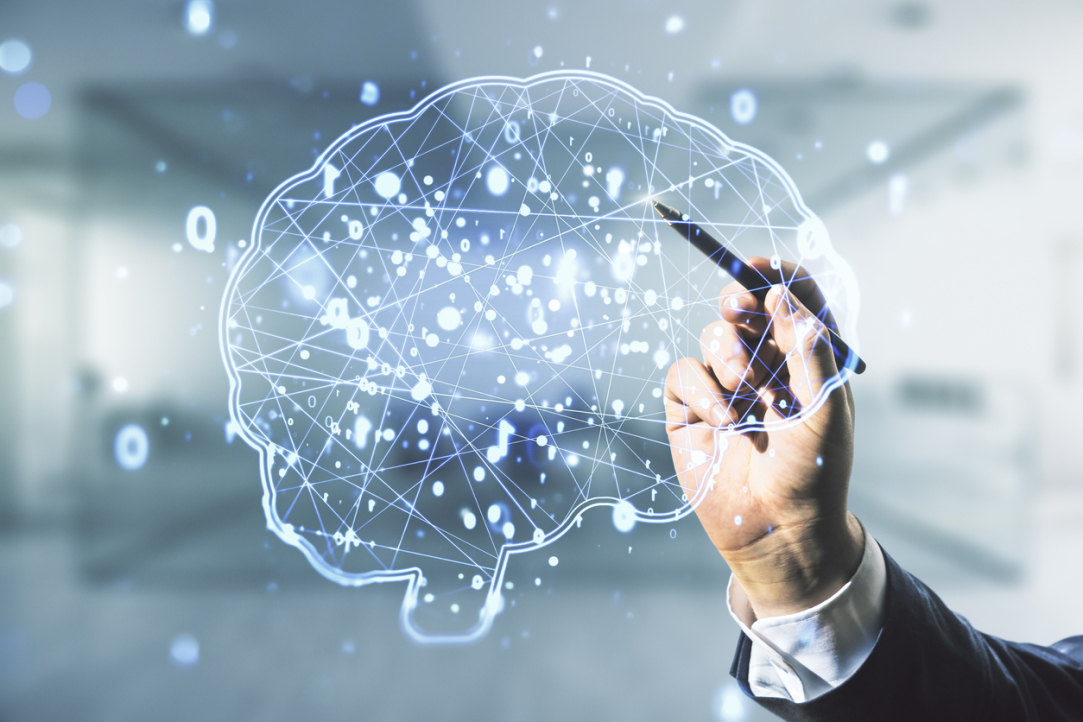Researchers Come Up with a New Explanation of Processes that Underlie Working Memory

Researchers from the HSE Centre for Cognition & Decision Making have developed a computational model of working memory and demonstrated the stabilizing effect of gamma oscillations, as well as the importance of fast interaction between the model components. The study results have the potential to become part of a theoretical basis for experiments on improving working memory functions with non-invasive brain stimulation. The study was published in Frontiers in Neural Circuits.
Human memory has a complicated structure that allows the brain to store information at various timescales. When it is needed to perform actions based on information that is currently unavailable to sensory organs, the human brain relies on working (short-term) memory. We need it to perform reasoning, reflect, understand complex information, and make decisions.
The human brain constantly produces electrical activity. Neurons are the brain cells that exchange information using brief electric impulses (spikes). When information is retained in working memory, neurons in the prefrontal cortex are in the active state characterized by an increased firing rate (i.e. rate of spike generation). In addition to the spiking activity of individual neurons, working memory also relies on the collective rhythmic activity of brain neural networks in different frequency bands.
Among the various types of brain rhythmic activity that are observed during working memory retention, gamma-band oscillations seem particularly interesting. The gamma band spans the frequencies of brain oscillations from 40 to 170 Hz. Gamma activity indicates the activation of neural networks and coincides with the periods of increased firing rate in these networks. While information is retained in working memory – when the stimulus is no longer present but information about it is required for a further decision – an increased intensity of gamma oscillations is observed. This stands in contrast to the background state when there is no need to retain information in the working memory.
There are many computational models of working memory today, most of which are based on neural networks with multiple steady states. In the simplest case, the system has two steady states: the background state with a low firing rate (which corresponds to the absence of information in the working memory), and the active state with a high firing rate (which corresponds to the retention of information in the working memory). The transition from the background to the active state is triggered by an external impulse representing a to-be-retained stimulus. Recent research has demonstrated that the active state is stable only during short periods of time (this phenomenon is called ‘metastability’). In addition, it is known that the processes related to working memory retention are not localized in one area but distributed across the cortex.
In their paper, the authors considered a working memory model that contains a set of neuron populations linked by excitatory connections. The researchers assumed that the information about the presented stimulus is delivered to many populations of the prefrontal cortex, but only some of them participate in the stimulus retention assembling into a single functional network. Each population receives an input from the whole network: that is why various parts of the network receive similar input signals. This was modeled as a common noise input into some of the modeled populations (the remaining populations receive independent noise inputs).
Each of the populations had a stable background state and a metastable active state. The stability of working memory retention was evaluated as the average time in which a population returned to the background state after the presentation of a stimulus. The authors demonstrated that the retention is more robust in the group of populations that receive a common noise input as compared to the group of populations that receive independent noise inputs. The authors also discovered that gamma-band input caused working memory stabilization and amplified the difference between the two groups of populations, thus increasing the ‘fidelity’ of the retained information. The effect was most evident when the connections between the populations were fast and the gamma input was delivered to each population in the same phase.

Currently, the theoretical understanding of the role of brain oscillations in working memory is falling behind the accumulated experimental material. The paper by HSE researchers contributes further to the development of the theory describing oscillatory control of working memory processes.

Nikita Novikov, Junior Research Fellow at the Centre for Cognition & Decision Making
Our paper continues the series of theoretical studies that explore the link between neural oscillations and working memory, expanding the current understanding of this link. For example, classical papers in this field indicated the destabilizing role of oscillations and the importance of slow neural interaction for working memory retention. In our paper, we demonstrated the opposite effect — the stabilizing role of the oscillations and the importance of fast interaction. The results we obtained have the potential to become a part of the theoretical basis for experiments on improving working memory functions with non-invasive brain stimulation.
Nikita Novikov
Junior Research Fellow, Centre for Cognition & Decision Making
See also:
Scientists Uncover Why Consumers Are Reluctant to Pay for Sugar-Free Products
Researchers at the HSE Institute for Cognitive Neuroscience have investigated how 'sugar-free' labelling affects consumers’ willingness to pay for such products. It was found that the label has little impact on the products’ appeal due to a trade-off between sweetness and healthiness: on the one hand, the label can deter consumers by implying an inferior taste, while on the other, it signals potential health benefits. The study findings have been published in Frontiers in Nutrition.
Internal Clock: How Heart Rate and Emotions Shape Our Perception of Time
Our perception of time depends on heart rate—this is the conclusion reached by neuroscientists at HSE University. In their experiment, volunteers watched short videos designed to evoke specific emotions and estimated each video's duration, while researchers recorded their heart activity using ECG. The study found that the slower a participant's heart rate, the shorter they perceived the video to be—especially when watching unpleasant content. The study has been published in Frontiers in Psychology.
Scientists Develop New Method to Detect Motor Disorders Using 3D Objects
Researchers at HSE University have developed a new methodological approach to studying motor planning and execution. By using 3D-printed objects and an infrared tracking system, they demonstrated that the brain initiates the planning process even before movement begins. This approach may eventually aid in the assessment and treatment of patients with neurodegenerative diseases such as Parkinson’s. The paper has been published in Frontiers in Human Neuroscience.
HSE Scientists Test New Method to Investigate Mechanisms of New Word Acquisition
Researchers at the HSE Centre for Language and Brain were among the first to use transcranial alternating current stimulation to investigate whether it can influence the acquisition of new words. Although the authors of the experiment have not yet found a link between brain stimulation and word acquisition, they believe that adjusting the stimulation parameters may yield different results in the future. The study has been published in Language, Cognition and Neuroscience.
When Thoughts Become Movement: How Brain–Computer Interfaces Are Transforming Medicine and Daily Life
At the dawn of the 21st century, humans are increasingly becoming not just observers, but active participants in the technological revolution. Among the breakthroughs with the potential to change the lives of millions, brain–computer interfaces (BCIs)—systems that connect the brain to external devices—hold a special place. These technologies were the focal point of the spring International School ‘A New Generation of Neurointerfaces,’ which took place at HSE University.
How the Brain Responds to Prices: Scientists Discover Neural Marker for Price Perception
Russian scientists have discovered how the brain makes purchasing decisions. Using electroencephalography (EEG) and magnetoencephalography (MEG), researchers found that the brain responds almost instantly when a product's price deviates from expectations. This response engages brain regions involved in evaluating rewards and learning from past decisions. Thus, perceiving a product's value is not merely a conscious choice but also a function of automatic cognitive mechanisms. The results have been published in Frontiers in Human Neuroscience.
Electrical Brain Stimulation Helps Memorise New Words
A team of researchers at HSE University, in collaboration with scientists from Russian and foreign universities, has investigated the impact of electrical brain stimulation on learning new words. The experiment shows that direct current stimulation of language centres—Broca's and Wernicke's areas—can improve and speed up the memorisation of new words. The findings have been published in Neurobiology of Learning and Memory.
HSE Researchers Discover Simple and Reliable Way to Understand How People Perceive Taste
A team of scientists from the HSE Centre for Cognition & Decision Making has studied how food flavours affect brain activity, facial muscles, and emotions. Using near-infrared spectroscopy (fNIRS), they demonstrated that pleasant food activates brain areas associated with positive emotions, while neutral food stimulates regions linked to negative emotions and avoidance. This approach offers a simpler way to predict the market success of products and study eating disorders. The study was published in the journal Food Quality and Preference.
HSE Neurolinguists Create Russian Adaptation of Classic Verbal Memory Test
Researchers at the HSE Centre for Language and Brain and Psychiatric Hospital No. 1 Named after N.A. Alexeev have developed a Russian-language adaptation of the Rey Auditory Verbal Learning Test. This classic neuropsychological test evaluates various aspects of auditory verbal memory in adults and is widely used in both clinical diagnostics and research. The study findings have been published in The Clinical Neuropsychologist.
Researchers at HSE Centre for Language and Brain Reveal Key Factors Determining Language Recovery in Patients After Brain Tumour Resection
Alina Minnigulova and Maria Khudyakova at the HSE Centre for Language and Brain have presented the latest research findings on the linguistic and neural mechanisms of language impairments and their progression in patients following neurosurgery. The scientists shared insights gained from over five years of research on the dynamics of language impairment and recovery.


